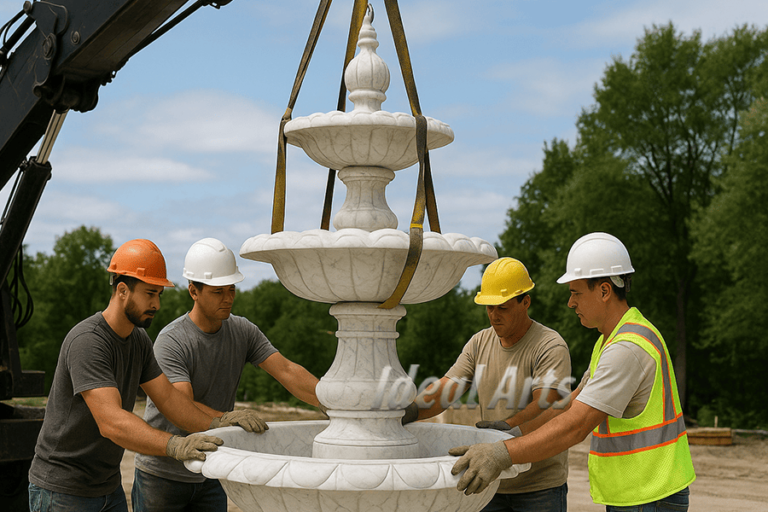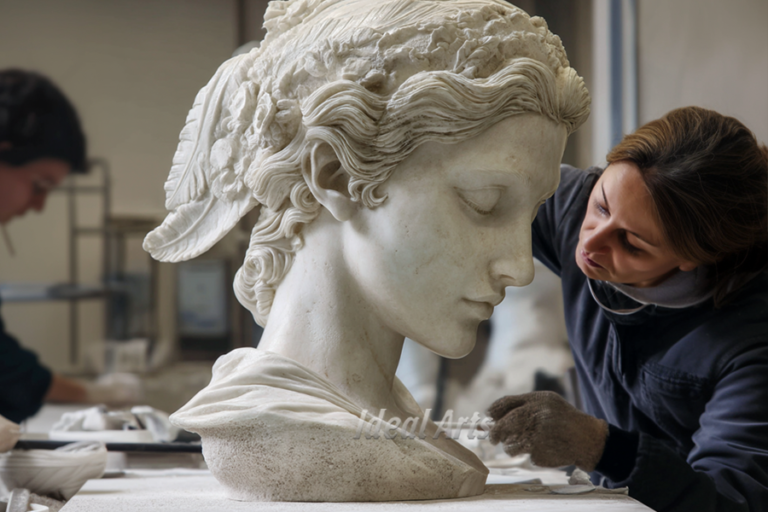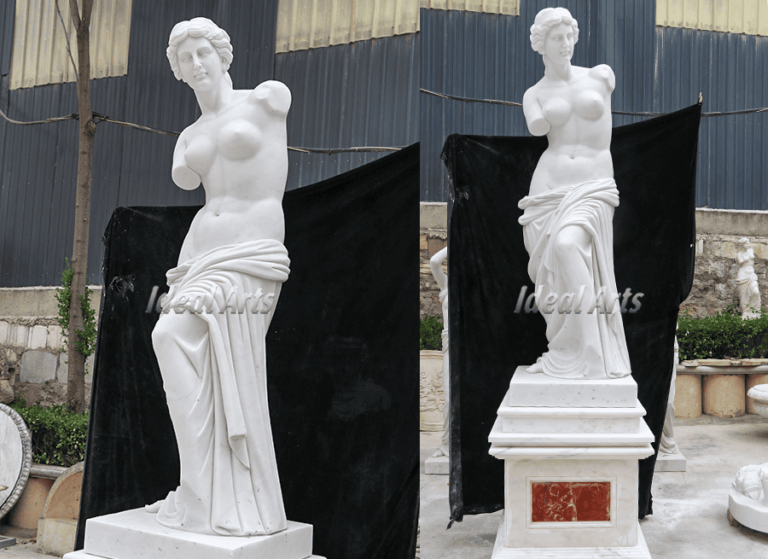
Marble greek statues are muscular because they embody the ancient Greeks’ dedication to physical beauty and strength. But why are Greek sculptures muscular? This artistic choice reflects their admiration for gods, heroes, and athletes, often portrayed with idealized physiques. Sculptors didn’t merely replicate nature; they enhanced it. Johann Joachim Winckelmann noted that Greek artists fused human and divine qualities to craft perfect forms. The emphasis on muscularity mirrored a culture that celebrated fitness and athleticism. Iconic statues like the Discus Thrower and Hercules highlight this ideal, combining anatomical precision with artistic brilliance. These masterpieces illustrate the balance between physical power and cultural values.
Key Takeaways
- Marble greek statues show muscles to represent beauty and strength, inspiring admiration for perfect bodies.
- Ancient Greeks cared about fitness and health. They believed a strong body showed inner strength and good character.
- Artists studied the human body to make realistic figures. They mixed real details with creativity to honor the human form.
- The Olympic Games helped promote sports and strong bodies. This influenced how muscles were shown in sculptures.
- Greek gods and heroes were examples for artists. They showed the importance of strength, beauty, and greatness in their culture.
Cultural Ideals of Physical Beauty

The Greek Ideal of Perfection
The ancient Greeks believed in achieving perfection in all aspects of life, including the human body. You can see this ideal reflected in their sculptures, which often depict muscular and well-proportioned figures. These statues weren’t just artistic expressions; they represented the Greeks’ pursuit of harmony between body and mind. To them, a strong and balanced physique symbolized inner strength and moral character.
When you look at sculptures like the Discobolus (Discus Thrower), you notice how every muscle is carefully defined. This attention to detail wasn’t accidental. Sculptors aimed to create an idealized version of the human form, blending realism with artistic imagination. They wanted to inspire you to strive for excellence, both physically and mentally. This concept of perfection influenced not only their art but also their daily lives, as physical fitness became a cultural priority.
Health and Fitness as Cultural Values
For the Greeks, physical fitness wasn’t just about appearance. It played a vital role in maintaining health and preventing disease. Physicians like Hippocrates and Galen emphasized the importance of exercise in their medical teachings. They believed that regular physical activity could improve your overall well-being and even extend your life. Their ideas shaped medical thought for centuries, proving how deeply fitness was embedded in Greek culture.
You might find it fascinating that the Greeks categorized exercises and prescribed specific activities to enhance health. Ball games, running, and weightlifting were common practices. These activities weren’t just for athletes; they were part of everyday life. Artworks from the period often depict these exercises, highlighting their significance. For example, the Belvedere Torso showcases the idealized male form, celebrating the connection between fitness and beauty.

The Olympic Games also played a crucial role in promoting fitness. These events celebrated athleticism and encouraged you to value physical strength and endurance. The games weren’t just competitions; they were cultural festivals that united people and reinforced the importance of health and fitness in society.
So, why are Greek sculptures muscular? They reflect a culture that valued physical fitness as a cornerstone of health and beauty. These ideals continue to inspire admiration and serve as a reminder of the Greeks’ dedication to excellence.
Athletics and Competition
The Role of the Olympic Games
The Olympic Games played a central role in ancient Greek culture, celebrating physical strength, skill, and competition. These games weren’t just athletic events; they were a reflection of the Greeks’ admiration for excellence and their competitive spirit. You can imagine the excitement as athletes from across the Greek world gathered to compete in events that tested their speed, endurance, and power.
Some of the key events included:
- Stadion (foot race): A short sprint of about 192 meters, showcasing speed.
- Diaulos (double-length foot race): A 384-meter race that combined speed with endurance.
- Dolichos (long-distance race): A grueling event requiring exceptional stamina.
- Pentathlon: A combination of five events, including running, wrestling, and discus throwing, testing all-around athletic ability.
- Wrestling and Boxing: These events highlighted strength, technique, and resilience.
- Pankration: A no-holds-barred contest blending wrestling and boxing.
- Chariot and Horse Racing: These prestigious events demonstrated skill and control.
- Hoplitodromos (race in armor): A unique race where competitors ran in full armor, symbolizing the connection between athleticism and military readiness.
The competitive nature of these games influenced Greek art. Sculptors often depicted athletes in their prime, with muscular physiques that symbolized strength and beauty. These statues weren’t just art; they were a tribute to the ideals celebrated in the Olympic Games.
Gymnasiums and Physical Training
Gymnasiums in ancient Greece were more than just places to exercise. They served as centers for both physical training and intellectual growth. When you stepped into a gymnasium, you entered a space where the pursuit of physical perfection intertwined with the development of the mind. This belief in the harmony of body and intellect shaped the cultural values of the time.
In these gymnasiums, athletes trained rigorously to achieve the muscular physiques you see in Greek sculptures. The connection between gymnasium culture and art is clear. Sculptors used these idealized bodies as models, creating statues that reflected not only physical strength but also intellectual achievement. For the Greeks, a muscular body symbolized more than athletic ability; it represented discipline, balance, and excellence.
The gymnasium culture also linked muscularity to divine and heroic ideals. Sculptures of gods and heroes often displayed exaggerated musculature, inspiring worshippers to strive for similar perfection. These depictions reinforced the belief that physical and moral excellence were interconnected.
When you ask, “Why are Greek sculptures muscular?” the answer lies in the values celebrated in gymnasiums and competitions. These spaces and events shaped the artistic representations of strength and beauty that continue to captivate us today.
Heroism and Mythology

Mythological Heroes and Their Influence
Mythological heroes played a significant role in shaping the muscular forms you see in Greek sculptures. These figures, like Heracles (Hercules), symbolized extraordinary strength and courage. Sculptors often exaggerated their muscles to emphasize their superhuman abilities and divine lineage.
- Heracles, known for his legendary feats, was frequently depicted with a powerful, muscular physique. His statues, such as the Farnese Hercules, highlight his immense strength and heroic status.
- Achilles, another celebrated hero, was portrayed as both brave and physically imposing. His depictions reflected his unmatched abilities on the battlefield.
- These representations became a form of hero worship, showcasing the cultural values of strength, beauty, and excellence.
Sculptors used these heroes as models of physical perfection. Their exaggerated musculature served as a visual metaphor for their larger-than-life qualities. You can see how these ideals influenced Greek art, connecting divine attributes with human aspirations.
- Mythological heroes embodied the Greeks’ admiration for physical and moral excellence.
- Sculptors aimed to inspire you by creating statues that celebrated these heroic ideals.
- The muscular forms in these works reflected the Greeks’ belief in striving for greatness.
Gods as Models of Physical Perfection
Greek gods were often depicted as the ultimate models of physical perfection. Sculptors portrayed them with human characteristics but idealized their forms to surpass ordinary humans. This artistic choice reflected the Greeks’ religious devotion and cultural values.
- Early Greek sculptures, like those from the Archaic period, featured stiff and less detailed figures. Over time, artists developed more dynamic and expressive forms, as seen in the Hellenistic era.
- This evolution showcased the Greeks’ obsession with physical perfection, particularly in male figures.
- Sculptures of gods like Zeus and Apollo displayed flawless physiques, symbolizing their divine nature.
The Greeks believed that achieving a perfect body brought you closer to the divine. This belief inspired an obsession with fitness and beauty. Sculptors used their art to celebrate this connection between physical and spiritual excellence.
- Gods were imagined as ethereal beings with idealized human forms.
- Their depictions reinforced the cultural importance of striving for perfection.
- These sculptures continue to captivate you, reflecting the timeless appeal of Greek ideals.
When you ask, “Why are Greek sculptures muscular?” the answer lies in their admiration for heroes and gods. These figures represented the ultimate ideals of strength, beauty, and divinity, inspiring both ancient and modern audiences.

Artistic and Scientific Precision
Mastery of Human Anatomy
Greek sculptors achieved their remarkable precision by studying human anatomy in depth. They didn’t just observe the surface of the body; they analyzed the muscles, bones, and tendons beneath the skin. This understanding allowed them to create sculptures that looked lifelike and dynamic. You can see this mastery in works like Myron’s Discus Thrower, where every muscle appears engaged in the act of throwing. The detailed anatomy not only captures movement but also conveys the athlete’s strength and focus.
The Greeks idealized the human figure by emphasizing proportion and balance. They often used the golden ratio to create harmonious and aesthetically pleasing forms. This mathematical approach ensured that their sculptures looked both realistic and idealized. For example, the Belvedere Torso demonstrates how sculptors combined anatomical accuracy with artistic imagination to celebrate the human body’s beauty.
Their study of anatomy influenced later artists, especially during the Renaissance. The Greeks’ ability to depict the body in athletic poses and heroic acts set a standard for artistic excellence. When you admire these sculptures, you’re witnessing the result of centuries of anatomical study and artistic refinement.
Advances in Sculptural Techniques
Greek sculptors developed innovative techniques to bring their visions to life. One of the most significant advancements was contrapposto, a method that gave statues a more natural and relaxed pose. This technique shifted the weight of the figure onto one leg, creating a sense of movement and balance. You can see this in many Classical sculptures, where the figures appear ready to step off their pedestals.
For bronze sculptures, artists used the lost-wax casting method. This technique allowed them to create intricate and dynamic forms that were impossible with other materials. Marble sculptures required chiseling and polishing to achieve smooth, lifelike surfaces. Sculptors often chose Paros marble for its translucency, which mimicked the way light interacts with human skin.
Assemblage was another innovation. Artists combined multiple pieces to create larger, more complex compositions. This approach enabled them to depict dramatic scenes, such as Laocoön and His Sons, where every muscle contributes to the narrative of struggle and tension.
These techniques, combined with their anatomical knowledge, helped Greek sculptors create the muscular physiques that continue to captivate you today. When you ask, “Why are Greek sculptures muscular?” the answer lies in their artistic precision and scientific understanding.
Greek sculptures emphasize muscular physiques to reflect ideals of beauty, strength, and perfection. These works celebrate cultural values like athleticism, heroism, and intellectual harmony. You can see their influence in modern art, where principles of proportion, balance, and symmetry continue to shape creative practices. Artists like Michelangelo drew inspiration from Greek sculptures, blending their techniques into masterpieces.
The legacy of these sculptures extends beyond art. They inspire discussions about physical beauty and strength, influencing design aesthetics and cultural ideals. When you admire these statues, you witness a timeless pursuit of excellence. Why are Greek sculptures muscular? They embody a culture’s dedication to perfection, leaving a legacy that still captivates today.

FAQ
Why do Greek sculptures focus on male figures more than female ones?
Greek culture celebrated male athleticism and heroism. Sculptors often used male athletes and gods as symbols of strength and perfection. Female figures, while present, were typically portrayed with softer forms to emphasize grace and beauty rather than muscularity.
Did Greek sculptors use real people as models?
Yes, sculptors studied real athletes and individuals to understand anatomy. However, they didn’t replicate exact bodies. Instead, they idealized features to create perfect forms that symbolized strength, balance, and harmony.
Why do some Greek sculptures appear incomplete or damaged?
Time and environmental factors caused damage to many sculptures. Wars, natural disasters, and centuries of exposure to the elements contributed to their current state. Despite this, their artistic brilliance still shines through.
How did Greek sculptors achieve such lifelike details?
They studied human anatomy extensively. Techniques like contrapposto and lost-wax casting helped them create realistic poses and intricate details. Their dedication to precision made their sculptures appear dynamic and alive.
Are Greek sculptures still influential today?
Absolutely! Artists and designers continue to draw inspiration from Greek sculptures. Their focus on proportion, symmetry, and beauty influences modern art, architecture, and even fitness ideals. These timeless works remain a benchmark for artistic excellence.





